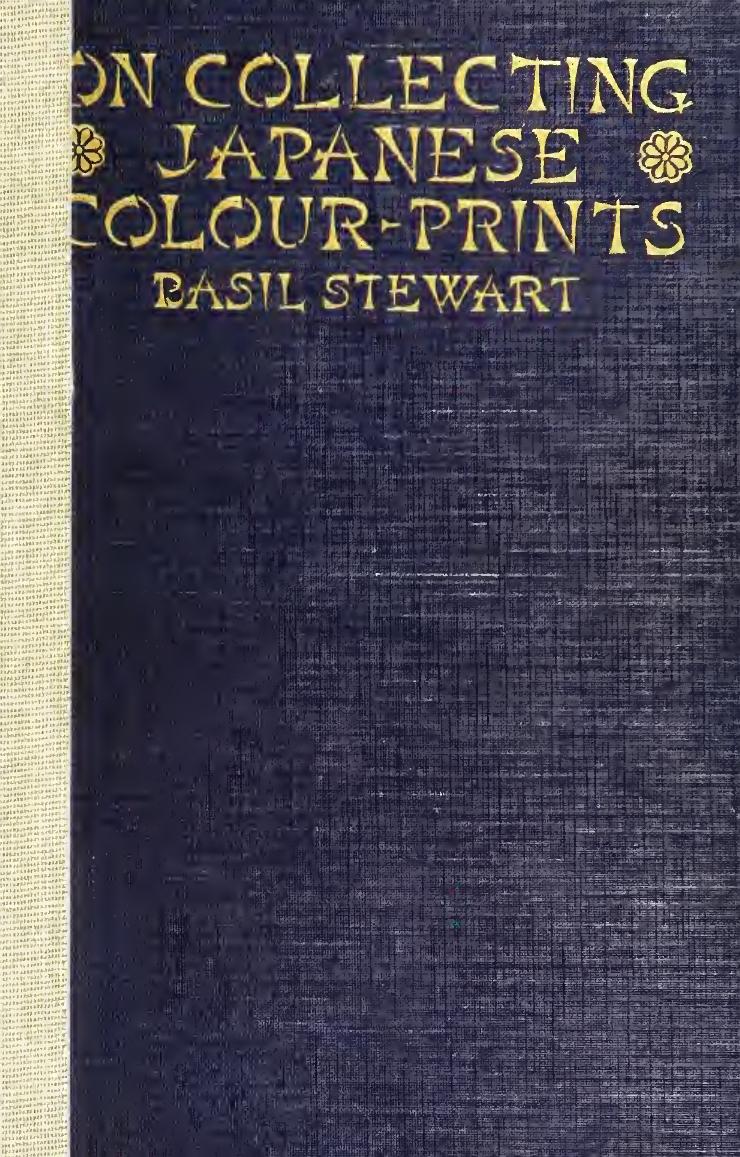On collecting Japanese colour-prints; being an introduction to the study and collection of the colour-prints of Ukiyoye school of Japan. Illustrated by examples from the author's collection by Stewart Basil 1880-

Author:Stewart, Basil, 1880-
Language: eng
Format: epub, pdf
Tags: Color prints, Japanese, Engraving
Publisher: New York, Dodd, Mead & company
Published: 1917-03-25T05:00:00+00:00
Full length portrait of a Geisha: inset a playing card with portrait of the poetess, Sei-sho-nagon. {Vcry early li'OYh).
Key: I Yei
earliest form
3 % 5
fud^ (0 Date cypher; Publisher: (with brtish) (?)c.*i8oo ^'i^za-kna
F(ue p. 60.]
[Plate Xi: 13.
ARTISTS OF THE UKIYOYE SCHOOL 6i
prints. Many of them are seal-dated, and any up to 1810 are good; but his late work (c. 1820-1829) follows too much the exaggerated and over-dressed figures of Kunisada, though he avoids the latter's glaring colours.
Another artist of this period, somewhat similar in name, is Keisai Yeisen (1789-1848). Von Seid-litz wrongly states him to be a pupil of Yeizan, owing no doubt to the fact that the first syllable of both their names is "Yei." Yeisen, however, was a pupil of Hakukeisai, the last half of whose name he took for his first, Keisai. Also the styles, both in colour and design, of Yeizan and Yeisen differ too much for the latter to have been a pupil of the former. Again, Yeisen was a more original designer thaa Yeizan, and did both landscapes and figure studies, whereas Yeizan confined himself to the drawing of women, though he often used a landscape background in his triptyches. Yeisen's best work was done in landscape, being collaborator with Hiroshige for the series of " Sixty-nine Stations on the Kiso Road."
His masterpieces are two very &neyiakemono-ye worthy to rank with similar masterpieces of Hokusai and Hiroshige; one a moonUght scene with a bridge
62 JAPANESE COLOUR-PRINTS
across a stream in the foreground, and behind high mountain-peaks—a fit companion to Hiroshige's " Monkey bridge " kakemono-ye. This print is exceedingly rare, a very fine copy changing hands in the Happer sale for £84. The other is a design of a carp, the Japanese emblem of perseverance, leaping up a waterfall, better known than the former as being less rare, and worth about £8 to £10, according to its condition. Other good prints by him in landscape are his series of waterfalls in imitation of the set by Hokusai. These also are rare. His figure studies, which are fairly numerous and not difficult to obtain, are the output of his later years. The collector should not miss the opportunity of picking up good copies of his blue prints, in which the whole design is printed in blue ; their effect is very pleasing, even though the actual drawing may not be of a very high order.
He also designed some good surimono. He signs himself in full, Keisai Yeisen, or Yeisen only, or Keisai only. In the latter case he should not be confused with KeisM, a designer of surimono and pupil of Hokkei, whose full name is Kiko Keisu.
KiYOMiNE (1786-1868) was the fifth and prac-
Keisat Yeisen (i789-i.S4.S.'
Download
On collecting Japanese colour-prints; being an introduction to the study and collection of the colour-prints of Ukiyoye school of Japan. Illustrated by examples from the author's collection by Stewart Basil 1880-.pdf
This site does not store any files on its server. We only index and link to content provided by other sites. Please contact the content providers to delete copyright contents if any and email us, we'll remove relevant links or contents immediately.
Aircraft Design of WWII: A Sketchbook by Lockheed Aircraft Corporation(32143)
The Great Music City by Andrea Baker(30930)
Call Me by Your Name by André Aciman(19961)
The Art of Boudoir Photography: How to Create Stunning Photographs of Women by Christa Meola(18422)
The Secret History by Donna Tartt(18266)
Shoot Sexy by Ryan Armbrust(17568)
Plagued by Fire by Paul Hendrickson(17125)
Portrait Mastery in Black & White: Learn the Signature Style of a Legendary Photographer by Tim Kelly(16880)
Adobe Camera Raw For Digital Photographers Only by Rob Sheppard(16808)
Photographically Speaking: A Deeper Look at Creating Stronger Images (Eva Spring's Library) by David duChemin(16512)
Ready Player One by Cline Ernest(14061)
Pimp by Iceberg Slim(13828)
Bombshells: Glamour Girls of a Lifetime by Sullivan Steve(13718)
The Goal (Off-Campus #4) by Elle Kennedy(13222)
Art Nude Photography Explained: How to Photograph and Understand Great Art Nude Images by Simon Walden(12860)
Kathy Andrews Collection by Kathy Andrews(11361)
The Priory of the Orange Tree by Samantha Shannon(8655)
Thirteen Reasons Why by Jay Asher(8490)
The remains of the day by Kazuo Ishiguro(8432)
